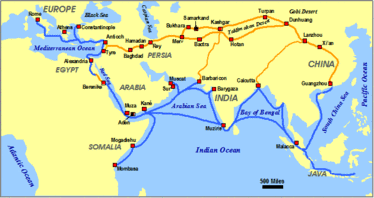In ancient times, the Silk Route, or Silk Road, was the commercial network that connected Asia, Africa and Europe with trade and cultural transmission routes.
Merchants, pilgrims, soldiers and nomads have gone through it for over two thousand years, following the different paths whose the route has been composed.
Today, silk is no more the main commodity of this road but it is going to once again become one of the most important trade route in the world.
Alluding to the ancient one, President Xi Jinping has launched in 2013 the ‘Silk Road Economic Belt’ project, an ambitious vision that will link again the three continent in new different ways.
Just like the ancient one, it will consist of both a land and a maritime route.
From Xi’an, in central China, it will cross Kazakhstan and heads southwest to Iran before passing through Iraq, Syria and Turkey. Then the Bosphorus and through Europe, traversing Bulgaria, Romania, the Czech Republic, Germany and Rotterdam in the Netherlands via Venice, where it converges with the planned maritime route. The latter begins in Quanzhou, Fujian. Touching other southern Chinese ports, goes through the Malacca Strait, from Kuala Lumpur to Kolkata and into the Indian Ocean. Then from Nairobi around the Horn of Africa and toward the Mediterranean – pointing Greece before reaching Italy.
It carefully avoids Russia, even if commercial partners. China is closely watching Russia’s geopolitical moves. After rejecting the Chinese initiative to create a free trade zone among the members of the Shanghai Cooperation Organization, Russia created its own Eurasian Custom Union with Kazakhstan and Belarus, passing through an action in Ukraine.
Beijing’s reaction has been equally clear. It can’t be easy having such neighbors.
But the ambitious project is not only a move to counter Russian influence.
Big investments have been done in what it deems to be major ports and railways leading to the European market.
Part of the strategy is intended to enforced the trade network from the west provinces to Central Asian neighbors, promoting the export of goods produced in Xinjian.
The creation of a Silk Road Economic Belt would allow the consolidation of long-term export in Central Asia for the western provinces, the poorest and most unstable of the nation.
Investments in the infrastructure of Central Asian states are also designed to stabilize the wider region both economically and politically, fearing a possible “domino effect” from neighbouring states to its Western provinces.
A further driver for the new Silk Road project is energy security.
Between 1989 and 2011, China enjoyed an average economic growth rate of 10%, and its energy needs have grown accordingly. Going from self-sufficiency in the 1980s to dependence on external sources in the early 2000s, China increased its energy imports from Russia thirty-fold to limit its dependency on the Middle East and sub-Saharan Africa.
Now, just like the EU, China has started to look for alternative sources of supply – mostly because Russia has demonstrated its willing to use the energy as a lever for political pressure.
The alternative routes for goods and energy will allow not only to bypass Russia, but also to reach Europe and its market quickly – not counting that if relations between Russia and the EU worsen, trade between Moscow and Beijing would increase significantly.
The Chinese President Xi Jinping has defined the new Silk Road Economic Belt as a “win-win proposal” and as he has declared “why not encourage a free trade zone that encompasses 3 billion people, has tremendous mineral and energy resources, and access to both Europe and the Middle East?”
It should not be difficult to guess what someone overseas think about it..

